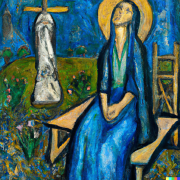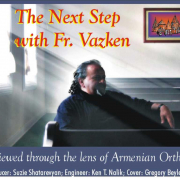Symbols
Armodoxy for Today: Symbols
As humans we search for meaning. Alongside survival and reproduction, the human animal has a need to find meaning in life. Religion helps facilitate the search. In that search, sooner or later, we come to a point where our faculties cannot comprehend the vastness of life with all its intricacies.
In the Book of Sirach or Ecclesiasticus, the author begins with a preface to his search (1:1-8):
All wisdom is from the Lord, and with him it remains for ever.
The sand of the sea, the drops of rain, and the days of eternity—who can count them?
The height of heaven, the breadth of the earth, the abyss, and wisdom—who can search them out?
Wisdom was created before all other things, and prudent understanding from eternity.
The root of wisdom—to whom has it been revealed? Her subtleties—who knows them?
There is but one who is wise, greatly to be feared, seated upon his throne—the Lord.
After 43 chapters of intense descriptions of the wonders of the Lord and the heavens and earth, he comes to very simple conclusion:
We could say more but could never say enough;let the final word be: ‘He is the all.’
Where can we find the strength to praise him? For he is greater than all his works. (43:27-28)
Symbols help us understand that which cannot be expressed with words. Symbols can be presented to us in a variety of ways. Their meaning is ascribed by the person who confronts them.
Red, white and blue string are merely dyed fibers. Sewn together in stripes and stars, they take on a new meaning. They are the symbol of a country and all that it represents. Before the strings are sewn, they may be cut, torn, destroyed or thrown in the trash. But once they come together to make a flag, those dyed fibers represent something huge and great. To destroy or desecrate the flag is an expression of disrespect. The meaning of a symbol also changes with the times and the circumstance of the people. On the days following 9/11 in 2001, the flag flying over the rubble of the Twin Towers came to represent the unity and resolve of a nation against evil. The backdrop of the towers and the collective experience of the citizens brought further meaning to the flag.
The main symbol of Christianity is the cross. Two planks, placed perpendicular to one another, joined together, with a short headspace, longer leg area, and the horizontal plank dissected in its center constituting a left and right arm. Two planks of wood can be cut, whittled, and used as kindling in a fire, but create them in the shape of a cross, they now have a deeper meaning.
This Sunday, the Armenian Church celebrates the fifth and last feast day of the year: The Exaltation of the Holy Cross. After the crucifixion and resurrection of our Lord Jesus Christ, the cross became an object of veneration.
The story of Exaltation can be found in all major Christian traditions. The Armenian Church celebrates four different feasts associated with the Holy Cross of Jesus, the main one being this Sunday’s Exaltation (or elevation) of the Holy Cross. The others are the Discovery (or finding) of the Cross, the Apparition of the Cross and the Holy Cross of Varak. This last one, the Cross of Varak, is unique to the Armenian Church and is celebrated two weeks following the Exaltation.
The Cross is a symbol. It means more than the two planks of wood which compose it. It is a symbol of victory over defeat, life over death and the power of love to overcome hate. It is the symbol of Christianity because in Jesus Christ we see and understand the same, that is, victory over defeat, life over death and the power of love to overcome hate.
Let us pray, O Christ, protector of the people, protect and shelter me under the shadow of your holy and precious Cross in peace. Delivery me from enemies invisible and visible so I may always glorify you with the Father and Holy Spirit. Amen.
Cover photo: How Thomas E. Franklin took the iconic 9/11 photo of firefighters (northjersey.com)


 2023 Fr. Vazken
2023 Fr. Vazken
 2019 Fr. Vazken
2019 Fr. Vazken





 2023 Fr. Vazken
2023 Fr. Vazken
Leave a Reply
Want to join the discussion?Feel free to contribute!